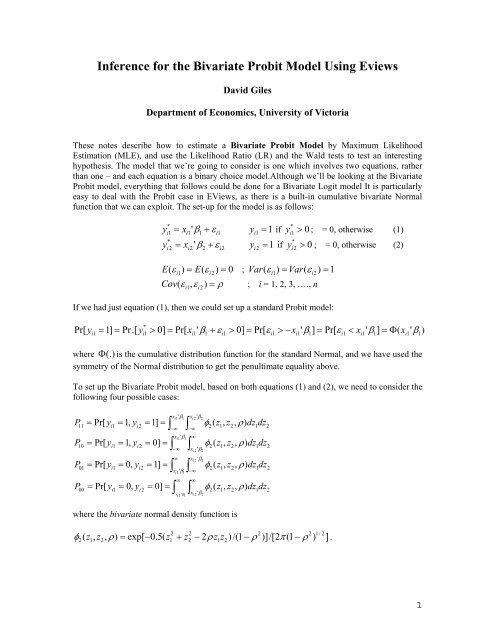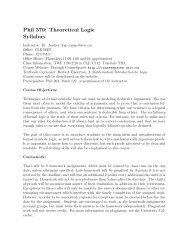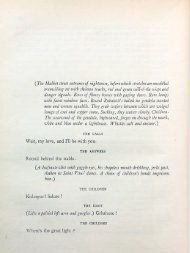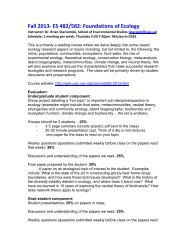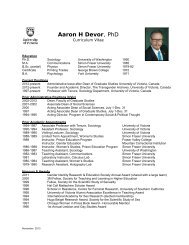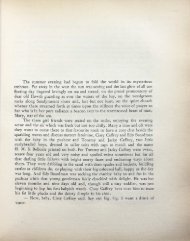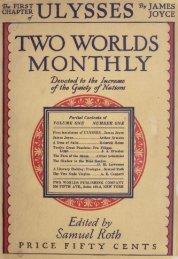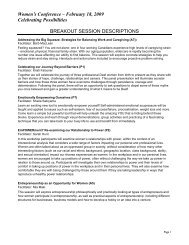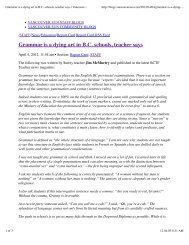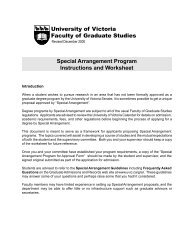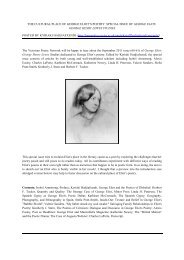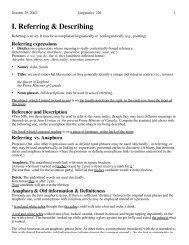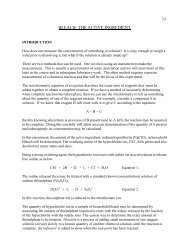bivariate probit.pdf - University of Victoria
bivariate probit.pdf - University of Victoria
bivariate probit.pdf - University of Victoria
You also want an ePaper? Increase the reach of your titles
YUMPU automatically turns print PDFs into web optimized ePapers that Google loves.
Inference for the Bivariate Probit Model Using Eviews<br />
David Giles<br />
Department <strong>of</strong> Economics, <strong>University</strong> <strong>of</strong> <strong>Victoria</strong><br />
These notes describe how to estimate a Bivariate Probit Model by Maximum Likelihood<br />
Estimation (MLE), and use the Likelihood Ratio (LR) and the Wald tests to test an interesting<br />
hypothesis. The model that we’re going to consider is one which involves two equations, rather<br />
than one – and each equation is a binary choice model.Although we’ll be looking at the Bivariate<br />
Probit model, everything that follows could be done for a Bivariate Logit model It is particularly<br />
easy to deal with the Probit case in EViews, as there is a built-in cumulative <strong>bivariate</strong> Normal<br />
function that we can exploit. The set-up for the model is as follows:<br />
*<br />
yi1 xi1'<br />
1 i1<br />
1 1 <br />
*<br />
y i if y i1<br />
0 ; = 0, otherwise (1)<br />
*<br />
y x y<br />
*<br />
1 if y 0 ; = 0, otherwise (2)<br />
i2<br />
i2<br />
' 2 i2<br />
2 i<br />
i2<br />
<br />
E( i1)<br />
E(<br />
i<br />
2)<br />
0 ; Var( i1)<br />
Var(<br />
i<br />
2)<br />
1<br />
Cov , ) ; i = 1, 2, 3, …., n<br />
( i1<br />
i2<br />
If we had just equation (1), then we could set up a standard Probit model:<br />
*<br />
Pr[ yi1 1]<br />
Pr.[<br />
yi1<br />
0]<br />
Pr[ xi1'<br />
1 i1<br />
0]<br />
Pr[ i1<br />
xi1'<br />
1]<br />
Pr[ i1<br />
xi1'<br />
1]<br />
(<br />
xi1'<br />
1)<br />
where (.) is the cumulative distribution function for the standard Normal, and we have used the<br />
symmetry <strong>of</strong> the Normal distribution to get the penultimate equality above.<br />
To set up the Bivariate Probit model, based on both equations (1) and (2), we need to consider the<br />
following four possible cases:<br />
P<br />
P<br />
P<br />
P<br />
11<br />
10<br />
01<br />
00<br />
Pr[ y<br />
Pr[ y<br />
i1<br />
Pr[ y<br />
i1<br />
Pr[ y<br />
i1<br />
i1<br />
1,<br />
y<br />
1,<br />
y<br />
<br />
<br />
0,<br />
0,<br />
i2<br />
i2<br />
y<br />
i2<br />
y<br />
i2<br />
1]<br />
<br />
<br />
0]<br />
<br />
1]<br />
<br />
<br />
0]<br />
xi1' xi2'2<br />
1<br />
<br />
<br />
x '<br />
i1<br />
1<br />
<br />
<br />
( z , z , )<br />
dz dz<br />
2<br />
<br />
xi<br />
2 '2<br />
2<br />
xi<br />
2 '2<br />
2<br />
xi1'1<br />
<br />
<br />
<br />
x 1 '<br />
x<br />
1 2 '<br />
i i 2<br />
1<br />
1<br />
2<br />
( z , z , )<br />
dz dz<br />
2<br />
1<br />
2<br />
( z , z , )<br />
dz dz<br />
1<br />
2<br />
( z , z , )<br />
dz dz<br />
where the <strong>bivariate</strong> normal density function is<br />
2 2<br />
2<br />
2 1/<br />
2<br />
( z , z , )<br />
exp[ 0.<br />
5(<br />
z z 2<br />
z z ) /( 1<br />
)] /[ 2<br />
( 1<br />
) ] .<br />
2<br />
1<br />
2<br />
1<br />
2<br />
1<br />
2<br />
2<br />
1<br />
1<br />
1<br />
1<br />
2<br />
2<br />
2<br />
2<br />
1
Then, the log-likelihood function for the <strong>bivariate</strong> model can be obtained in the following way:<br />
(i) Define q y 1<br />
and q y 1<br />
i1<br />
2 i1<br />
i2<br />
2 i2<br />
(ii) Define zij xij<br />
'<br />
j and wij qijzij<br />
; j = 1, 2<br />
*<br />
(iii) Define q q <br />
i i1<br />
i2<br />
*<br />
(iv) Then, Pr[ Y y , Y y ] ( w , w , )<br />
n<br />
1 i1<br />
2 i2<br />
2 i1<br />
i2<br />
i<br />
*<br />
(v) log L log ( w , w , )<br />
<br />
i1<br />
2<br />
i1<br />
i2<br />
i<br />
The EViews workfile, <strong>bivariate</strong> <strong>probit</strong>.wf1, contains data for the variables y1, y2, x1 and x2. The<br />
LOGL object, LOGL01, allows us to estimate a Bivariate Probit model for y1 and y2. See the<br />
READ_ME text object in the EViews workfile for more details.<br />
We can use a Wald test to test the hypothesis that the errors in the two equations <strong>of</strong> the model are<br />
independent. This amounts to testing H0: ρ = 0 against a 2-sided alternative. In terms <strong>of</strong> the<br />
EViews code, we need to test if c(5) = 0. The results are in the table titled<br />
Wald_Test_Result_01. In this case, we cannot reject H0, so in fact we would be justified in<br />
estimating 2 separate Probit models (see EQ01 and EQ02 in the EViews workfile).<br />
We can also use an LR test to test the hypothesis that the errors in the two equations <strong>of</strong> the model<br />
are independent. In this case we need the maximized value <strong>of</strong> the log-likelihood function from the<br />
<strong>bivariate</strong> <strong>probit</strong> model (i.e., the “unrestricted” model), and the maximized value <strong>of</strong> the loglikelihood<br />
function from the “unrestricted” model. The latter is just the sum <strong>of</strong> the 2 maximized<br />
log-likelihood values from the two individual <strong>probit</strong> models. Here, this number is –(32.96773 +<br />
30.44460) = -63.41233. So, the LR test statistic is 2( -63.16293+63.41233 +) = 0.4988. The p-<br />
2<br />
value based on the (asymptotic) ( 1)<br />
distribution is 0.4800, so again, we would not reject the null<br />
hypothesis.<br />
Finally, note that the model could be extended in several interesting ways. For example, suppose<br />
that we hypothesize that the correlation between the errors in the two equations <strong>of</strong> the model is<br />
proportional to a third variable, x3. In LOGL02 in the EViews workfile, the code for the loglikelihood<br />
function has been altered to allow for this refinement. If we now apply the Wald test to<br />
see if the errors <strong>of</strong> the two equations are independent we get the results in the text object titled<br />
Wald_Test_Result_02. Note that the p-value has dropped to approximately 7%, which may well<br />
alter our earlier conclusion. Of course, this is only an asymptotically valid test and our sample<br />
size is just n = 50, so we should be cautious.<br />
March, 2010<br />
2


